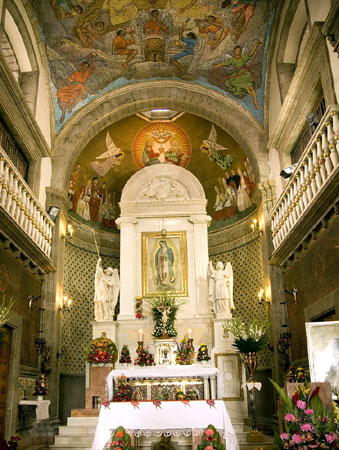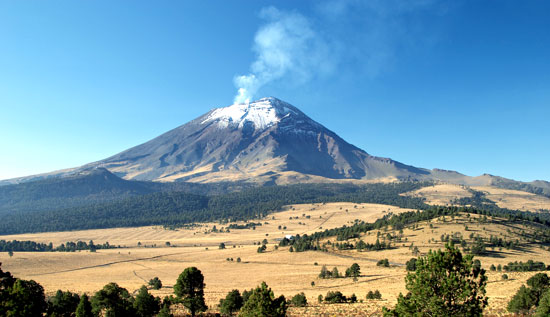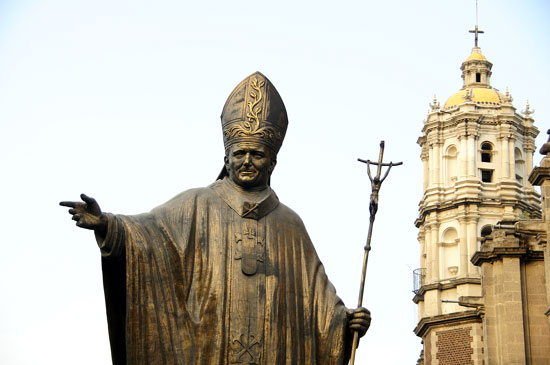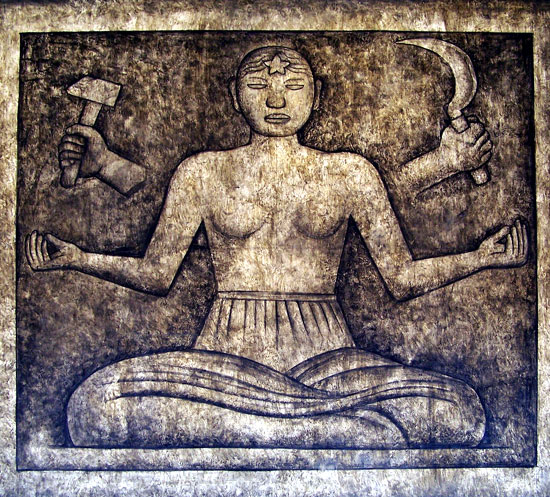Religion: Religion Overview
Religions of the Country
Christianity is followed by almost the entire Mexican population. Other religions practiced by small numbers include Jews, Buddhists, Jehovah’s Witnesses, and Muslims.
The dominant Christian sect in Mexico is Roman Catholicism, which claims about 90 percent of the country’s Christians. The remainder is divided among Protestant denominations including Presbyterians, Methodists, Baptists, Mennonites, Del Nazareno, Pentecostals, Mormons, Seventh-Day Adventists, and many other Evangelical groups.
Basic Tenets
The Catholic Church believes itself the legitimate successor to the ministry of Jesus Christ through uninterrupted apostolic succession from St. Peter to the present Pope. Like most other Christian faiths, Catholicism is both monotheistic and trinitarian, following one God in three forms, the Father, the Son, and the Holy Spirit. It holds that Jesus Christ, the Son, died and rose from the dead to redeem humanity from its sins. It considers scripture as well as church teachings and sacraments to be legitimate sources of revelation and grace. The sacrament of the Eucharist, or Holy Communion, is usually celebrated at Mass; Catholics go through a period of study before they may receive communion for the first time, as they believe in the real presence of Christ in the bread and wine. It is not true that Catholics worship saints and statues, but many Catholics have a special affection for certain saints and may use images to focus their minds as they ask a saint to intercede for them in heaven.
The Catholic Church regards human life as sacrosanct and opposes activities like cloning, eugenics, euthanasia, artificial birth control, and abortion.
Spiritually Devout or Nominal
The Mexicans are, in general, a devout people. However, the level of devotion has been steadily declining with each passing year. A majority of people, even those who do not attend regular church services, consider religion to be an important part of their lives. It is estimated that 55 percent of the population attends regular church services on a weekly basis, another 19 percent does so once a month, and 20 percent does so less than once a month. Participation in religious rites is high.
Religious Conflict
Most areas of Mexico witness an amicable relationship among the country’s different religious groups. The State of Chiapas, however, is an exception; the area experiences tensions that are religious, political, and social in nature.
Secularism
Mexico is an officially secular country and is not home to a secular movement.
Superstitions
A Mexican superstition prohibits a bride from wearing pearls on her wedding day, due to the belief that the pearls are the tears that she will cry in her married life. Another Mexican belief is specifically for girls who wish to get a boyfriend. They are required to buy a stamp or statue of San Antonio, place it upside down, and light a candle in front of it. There is a little prayer to be said to "order" the boyfriend and repetition of this practice on a daily basis for two weeks will supposedly result in the girl getting a boyfriend.
Mexicans strongly believe in the effects of the mal de ojo (evil eye). The mal de ojo is believed to be capable of inflicting illness, calamity, misfortune, and even death. They believe that it is strangers born with "strong vision" who are capable of casting the mal de ojo on people or objects they admire or desire. Extra care is taken for children, and strangers who admire a child must touch him or her with their hand to indicate that they do not harbor envy or desire.
An ancient legend of the Náhuas tells of a beautiful girl, named Iztaccíhuatl ("White Lady"), who was born to the Emperor and Empress of the Aztecs. She fell in love with a tribal chief called Popoca. When war broke out, the Emperor instructed Popoca to bring back the head of the enemy chief in order to win his daughter’s hand. While the war was being waged, Popoca’s enemies sent false word to the Emperor that Popoca has died in battle, upon which Iztaccíhuatl was so heartbroken that she died of sadness. When Popoca returned from the war and heard of her death, he carried her away to the mountains and buried her there. He then kept watch over her until he too died of sadness. The gods, touched by Popoca’s sacrifice, transformed them into volcanoes, Popocatépetl ("Smoking Mountain") and Iztaccíhuatl. Legend has it that when Popocatépetl spews out smoke, it shows that he is watching over Iztaccíhuatl, who still sleeps by his side. The profile of Iztaccíhuatl does indeed look like a woman lying down.
Religious Clerics
Religious clerics are widely respected and possess a good deal of authority over the general population due to the vast following of the Catholic Church and the influence that brings. Catholic leaders do not confine themselves to religious activities, preferring instead to play a large role in the country’s social and political spheres. They are active in criticizing human rights abuses and taking up social issues such as corruption. They are, however, barred from holding public office, supporting specific political parties, or acting against state laws. Among the general population, clerics are looked upon as counselors and religious advisors. Many Mexicans routinely turn to religious clerics for their spiritual needs.
Religious instruction is available at many theological seminaries and colleges, almost all of them Christian ones. These include the Mexico Central Bible Institute for Women Missionaries, the Presbyterian Theological Biblical Institute, the John Calvin I Seminary, and St. Paul’s Theological Seminary.
State Regulations
The Roman Catholic Church is subject to state regulations that determine its legal status, operational boundaries, and even the maximum number of clerics that can operate in certain regions. Religious clerics are not paid by the state.
Religion and Public Life
Religion, especially Roman Catholicism, is highly valued and plays an important role in Mexican society. The country is filled with churches and cathedrals, a testament to the importance of Christianity. Religious customs, practices, and symbolism find a place in the everyday lives of Mexicans and hold considerable cultural and social value. Catholic iconography is widely prevalent and can be found in locations ranging from street corners to taxis. The practice of Catholicism in Mexico often takes extreme forms such as self-flagellation and crawling to the altar on one’s knees.
Certain Catholic shrines are symbols of national pride and play host to many thousands of pilgrims every year. Popular shrines include the Shrine of Our Lady of Guadalupe (considered the patroness of the Americas) and Shrine of San Miguel Del Milagro. Despite the fall in church attendance with the advent of the younger generation, most Mexican youth continue to consider religion an important part of their lives.
Religious Holidays and Ceremonies
Christian religious holidays are the only ones officially recognized in Mexico. They include Maundy Thursday, Good Friday, Easter, All Souls’ Day, and Christmas. The Virgin of Guadalupe Day is a popular regional holiday.
Important religious ceremonies include baptism , confirmation, weddings, and funerals. Each of these is usually celebrated in a religious context. Mexicans celebrate All Soul’s Day (November 1) with a picnic on the graves of one’s ancestors, where people eat cookies and candies in the shape of skulls and skeletons.
Government and Religion
The Mexican Constitution provides the country’s citizens the freedom to practice the religion of their choice. It declares Mexico to be an officially secular country and prohibits the Congress from promulgating laws that establish a state religion or prohibit the practice of a specific religion. The government is not aligned with a particular religion or religious sect, and the Constitution provides for a formal separation between the church and state. The government curtails the activities of the Roman Catholic Church, despite its dominant status in the country’s religious arena. Until recently, there was a ban of government officials attending religious ceremonies in their official capacity. All religious groups can register themselves with the Director for Religious Affairs of the Federal Secretariat of Government, and registration requests are very rarely turned down. Registration gives them the status of a Registered Religious Association and an A.R. number, which is used to invite foreign missionaries.
Persecution
Despite the Catholic Church’s massive, almost universal following among Mexicans, the country’s laws severely restrict its activities. Certain Mexican states have established their own laws restricting the number of clerics, an extreme example being the Chihuahua state authorities permitting only one priest to serve the entire state’s Roman Catholic population. Religious leaders are also barred from criticizing the country’s laws and policies, and from openly expressing their political views or supporting political parties. Certain restrictions even apply to clerics wearing religious clothing in public. However, the government does not actively persecute any religious group.
Foreign missionaries and evangelical groups are allowed to freely operate and practice their beliefs with full freedom to assemble and conduct worship services. While the government only grants a limited number of visas to religious groups, the applications for such visas are usually granted. Foreigners wishing to engage in religious work in Mexico are required to obtain an FM-3 license. This can only be done by an invitation from a Registered Religious Association that has an A.R. number. Religious proselytizing is legally permitted. It is completely legal to possess, distribute, sell, and display religious materials and items.
Religious Tolerance
Mexico does experience a few clashes that are motivated by a mixture of religion, politics, and social issues. Most of these cases are resolved peacefully and religiously motivated outbreaks of violence are very rare.
The country has an Interfaith Council composed of members of different groups, such as the Anglicans, Catholics, Greek Orthodox, Mormons, Lutherans, Hindus, Buddhists, Jews, Sikhs, Muslims, and evangelical Protestant groups. The purpose of this council is to promote religious tolerance and sort out religious conflicts.
The dominant Roman Catholic Church does not adversely affect the activities of other religious groups, nor does it suppress or restrict their practices. Mexico’s population is very tolerant of other religions. The membership and presence of foreign evangelical groups has grown at a rapid pace, a sure indication of their widespread acceptance among the general populace. Religious proselytizing is culturally accepted.
Protocols for Foreigners
Foreigners are allowed to freely participate in the country’s religious activities and rituals, but non-Catholics attending Catholic Mass should refrain from taking the communion bread and wine. Foreigners wishing to lead worship services can only do so after fulfilling official requirements.
Copyright © 1993—2024 World Trade Press. All rights reserved.

 Mexico
Mexico 



